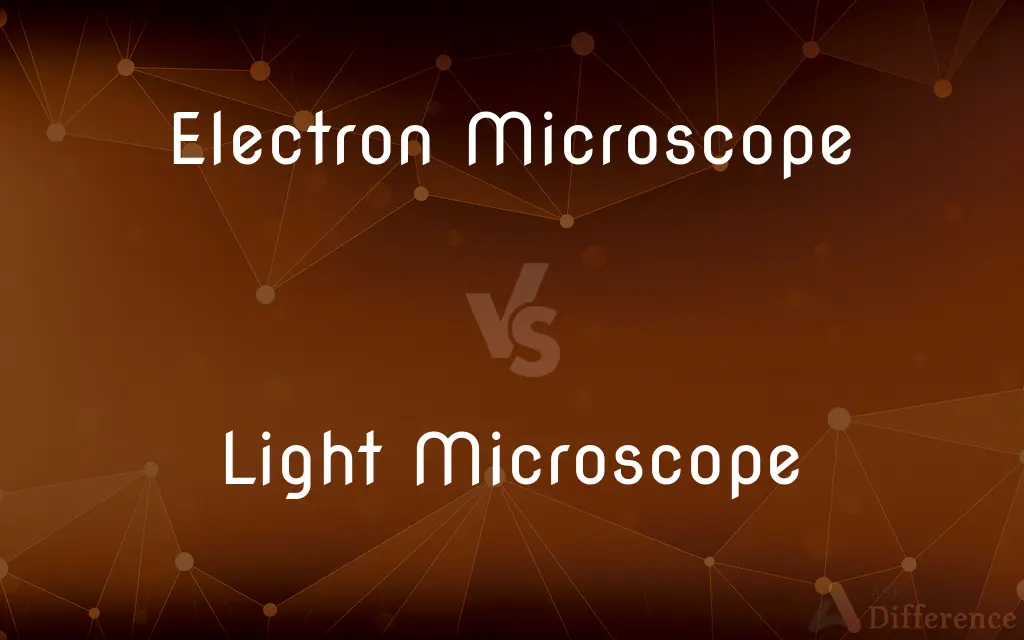Electron Microscope vs. Light Microscope — What's the Difference?
Edited by Tayyaba Rehman — By Urooj Arif — Published on December 19, 2024
Electron microscopes use electron beams for high-resolution imaging, while light microscopes use visible light, offering lower magnification.

Difference Between Electron Microscope and Light Microscope
Table of Contents
ADVERTISEMENT
Key Differences
Electron microscopes utilize a beam of electrons to illuminate the specimen, achieving magnifications of up to 10 million times. This allows for the observation of structures at the molecular and atomic levels. On the other hand, light microscopes use visible light and optical lenses to magnify images, typically up to 2000 times, making them suitable for viewing larger structures such as cells and tissues.
While electron microscopes provide higher resolution images, they require specimens to be placed in a vacuum and often need extensive sample preparation that can alter or damage the sample. Light microscopes, in contrast, can observe living specimens in their natural state, allowing for the study of biological processes in real time.
The complexity and cost of electron microscopes are significantly higher than those of light microscopes. This makes electron microscopes less accessible for routine use in classrooms and basic research laboratories. Light microscopes, being more affordable and easier to use, are widely available in educational institutions and for amateur enthusiasts.
Electron microscopes are divided into two main types: transmission electron microscopes (TEM) and scanning electron microscopes (SEM), each providing different types of images. TEMs offer detailed images of the internal structure of specimens, whereas SEMs give a three-dimensional view of the surface of specimens. Light microscopes, though less versatile in the types of images they provide, are indispensable for a wide range of applications, including medical diagnosis and microbiological research.
The preparation of samples for electron microscopy is a complex and time-consuming process that often involves dehydration, embedding, and sectioning of the specimen, as well as the application of heavy metals for contrast. Light microscopy, on the other hand, can often be performed with minimal sample preparation, such as staining, making it quicker and preserving the natural state of the specimen more effectively.
ADVERTISEMENT
Comparison Chart
Illumination Source
Electrons
Visible light
Magnification
Up to 10 million times
Up to 2000 times
Resolution
0.1 nanometers
200 nanometers
Sample Preparation
Complex, requires vacuum
Minimal, can view live specimens
Cost and Accessibility
High cost, less accessible
Lower cost, widely accessible
Compare with Definitions
Electron Microscope
More expensive and complex to operate.
Requires specialized training to use effectively.
Light Microscope
More affordable and accessible for educational purposes.
A basic model can be found in most schools.
Electron Microscope
Offers higher resolution due to shorter wavelength of electrons.
Structures as small as 0.1 nm can be resolved.
Light Microscope
Simple to operate, suitable for beginners.
Commonly used in high school biology labs.
Electron Microscope
Requires extensive sample preparation, including dehydration.
Specimens must be coated with heavy metals for imaging.
Light Microscope
Can observe living organisms.
Watching paramecia swim in pond water.
Electron Microscope
Ideal for materials science and biological research at the molecular level.
Used to examine the fine structure of cells and nanomaterials.
Light Microscope
Suitable for cell and tissue level observation.
Used to study plant and animal cells in detail.
Electron Microscope
Allows for detailed observation of molecular structures.
Electron microscopes can magnify viruses, unseen by light microscopes.
Light Microscope
Minimal preparation needed, preserves natural state.
A drop of blood can be directly observed under a slide.
Common Curiosities
What is the main difference between an electron microscope and a light microscope?
The main difference is the illumination source; electron microscopes use electrons, while light microscopes use visible light.
What is the highest magnification achievable with a light microscope?
Light microscopes can typically magnify up to 2000 times.
Can electron microscopes view live specimens?
No, the sample preparation and vacuum environment required for electron microscopy do not allow for the observation of living specimens.
Can you observe color with an electron microscope?
No, electron microscopes produce black and white images, as electrons do not carry color information.
Are electron microscopes available for use in high schools?
Due to their cost and complexity, electron microscopes are generally not available in high school settings.
Why do electron microscopes have higher resolution?
Because electrons have a much shorter wavelength than visible light, allowing for the observation of much smaller details.
How do you prepare a sample for electron microscopy?
Sample preparation involves dehydration, embedding in resin, sectioning, and often coating with a conductive material.
Can light microscopes be used to study viruses?
No, viruses are too small to be seen with a light microscope; electron microscopes are required.
How does the resolution of an electron microscope compare to that of a light microscope?
Electron microscopes have a significantly higher resolution, allowing them to reveal much finer details.
Why is sample preparation for electron microscopy considered a disadvantage?
It can be time-consuming and may alter or damage the specimen, potentially affecting the observation.
Is it possible to use a light microscope for molecular biology research?
Yes, light microscopes are used in molecular biology, particularly when studying larger structures or live cells.
What types of electron microscopes are there?
The two main types are transmission electron microscopes (TEM) and scanning electron microscopes (SEM).
What is the impact of the cost of electron microscopes on their accessibility?
The high cost and complexity of electron microscopes limit their accessibility, primarily to research institutions and universities.
What are the advantages of using a light microscope for educational purposes?
They are more affordable, simpler to operate, and can observe live specimens, making them ideal for educational settings.
Are there any specimens that can only be observed with an electron microscope?
Yes, ultra-small specimens like viruses and the fine details of cellular structures require an electron microscope.
Share Your Discovery

Previous Comparison
Liberals vs. Conservatives
Next Comparison
Purchase Order vs. InvoiceAuthor Spotlight
Written by
Urooj ArifUrooj is a skilled content writer at Ask Difference, known for her exceptional ability to simplify complex topics into engaging and informative content. With a passion for research and a flair for clear, concise writing, she consistently delivers articles that resonate with our diverse audience.
Edited by
Tayyaba RehmanTayyaba Rehman is a distinguished writer, currently serving as a primary contributor to askdifference.com. As a researcher in semantics and etymology, Tayyaba's passion for the complexity of languages and their distinctions has found a perfect home on the platform. Tayyaba delves into the intricacies of language, distinguishing between commonly confused words and phrases, thereby providing clarity for readers worldwide.














































